Owning the newest rifles gets expensive fast.
But what if I told you that there was an entire group of firearms that are fun to shoot, interesting to look at, and, best of all, generally much more affordable than the latest AR-15?
Sound too good to be true?
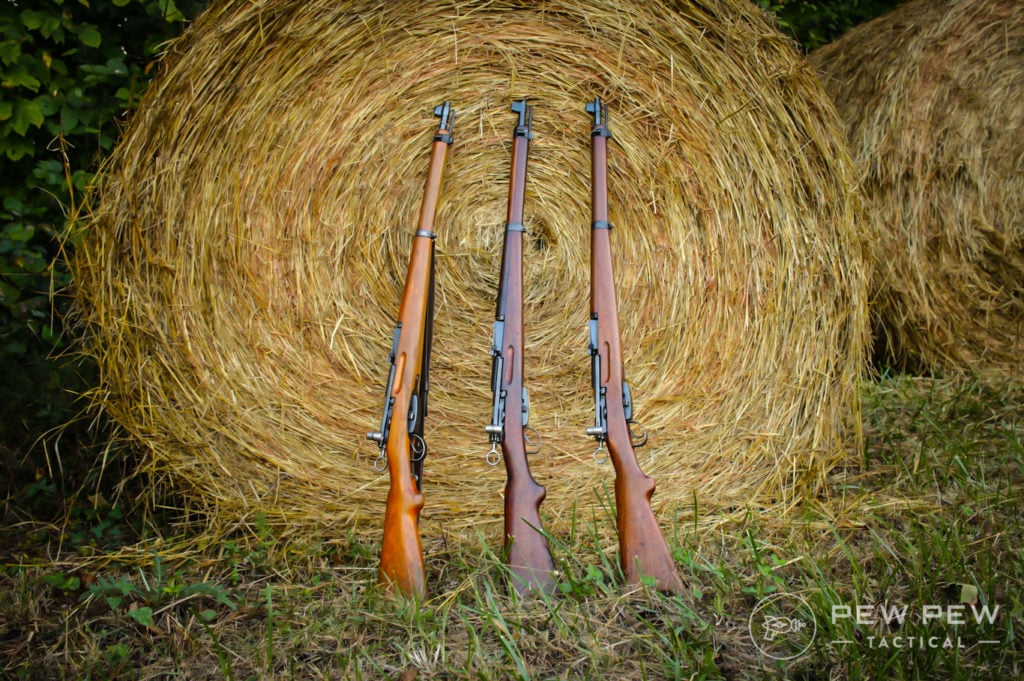
It turns out that you can add to your gun collection fairly cheaply by looking somewhere most people never bother…military surplus rifles.
These guns are battle-tested and make a great addition to any shooter’s collection.
If you are new to the idea of owning military surplus rifles or just interested in the topic in general, this article will cover a few of the best surplus rifles to own, and what it is that makes them worth owning.
THE QUICK LIST
-
Best Overall
-
Best US Mil-Surp
-
Best Straight-Pull
-
Best Bolt-Action
-
Best Budget Rifle
Table of Contents
Loading…
How We Tested the Best Military Surplus Rifles
Military surplus rifles have made appearances for target shooting and even hunting, so we know what works and what doesn’t. We’ve put thousands of rounds (presumably including a lot of cheap, steel-cased ammo) through these particular rifles and gladly slap them with our stamp of approval.
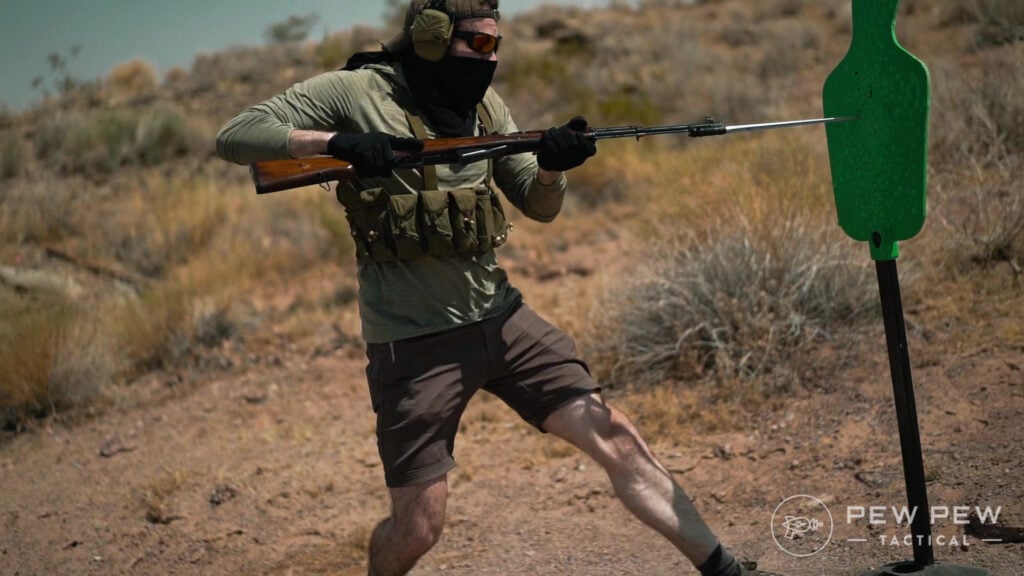
Every rifle here earned its place through hands-on time with the Pew Pew Tactical freelance writer team and editorial staff. We come from civilian, law enforcement, and military backgrounds – and we all love a good deal on a great rifle.
Best Military Surplus Rifles
1. SKS – Best Overall
Prices accurate at time of writing
Prices accurate at time of writing
-
25% off all OAKLEY products - OAKLEY25
Copied! Visit Merchant
Pros
- An affordable semi-automatic
- Reliable as a hammer
- Integrated bayonet (or spike)!
Cons
- Held back by the attached magazine
Specs
- Caliber: 7.62×39
- Action: Semi-automatic
- Loading: 10-round internal magazine
- Barrel Length: 20″
- Overall Length: 40″
- Origin: Soviet Union, China, Yugoslavia
The venerable SKS served in the military forces of dozens of countries across the Eastern Bloc and Asia.
SKS rifles come from Russia originally, but those tend to be tougher to find. Yugoslavian and Chinese SKS rifles seem to be a fair bit more common than the Russian models, and Yugos are often the most affordable option
There are so many SKS rifles in the states that Bubba has gotten his hands on them, and a ‘tactical’ SKS market has popped up.
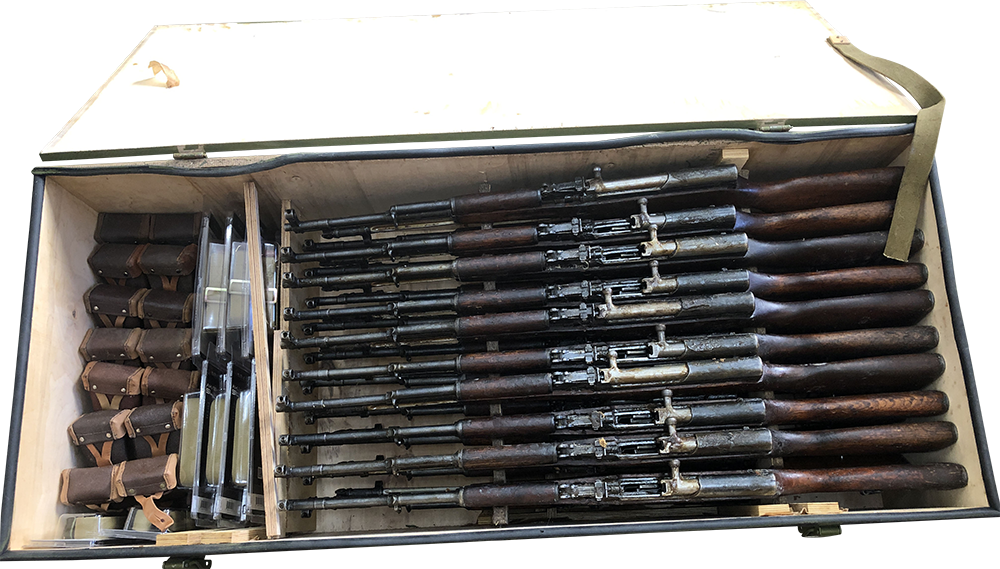
The SKS provides a semi-auto rifle that’s actually quite handy.
It’s more than just a surplus rifle and can be used as a working gun, a hunting rifle, and even a defensive weapon.
The fixed 10-round magazines make them Assault Weapons Ban-proof, which is rather nice.
SKS rifles use a short-stroke gas piston system that has been proven quite reliable. Like the AK, it eats when it’s filthy dirty, when it’s hot or cold, and when it’s not even hungry.
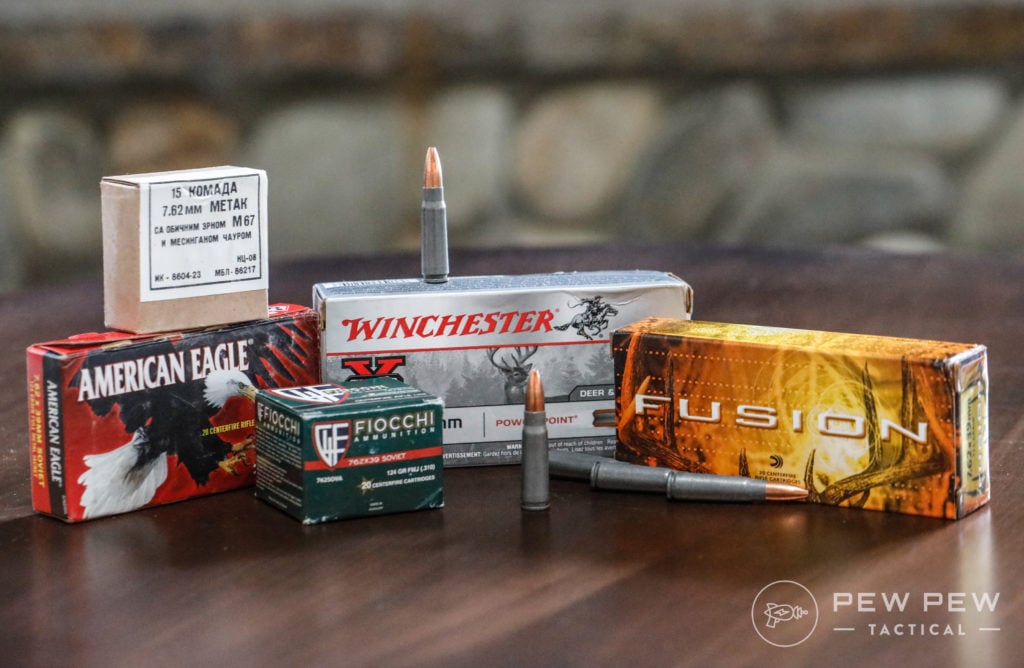
It fires the 7.63x39mm round — an abundant caliber in the United States and rather cheap.
It’s no sniper rifle but it puts lead where you need it. Screaming, “For the motherland” while you shoot may or may not improve accuracy.
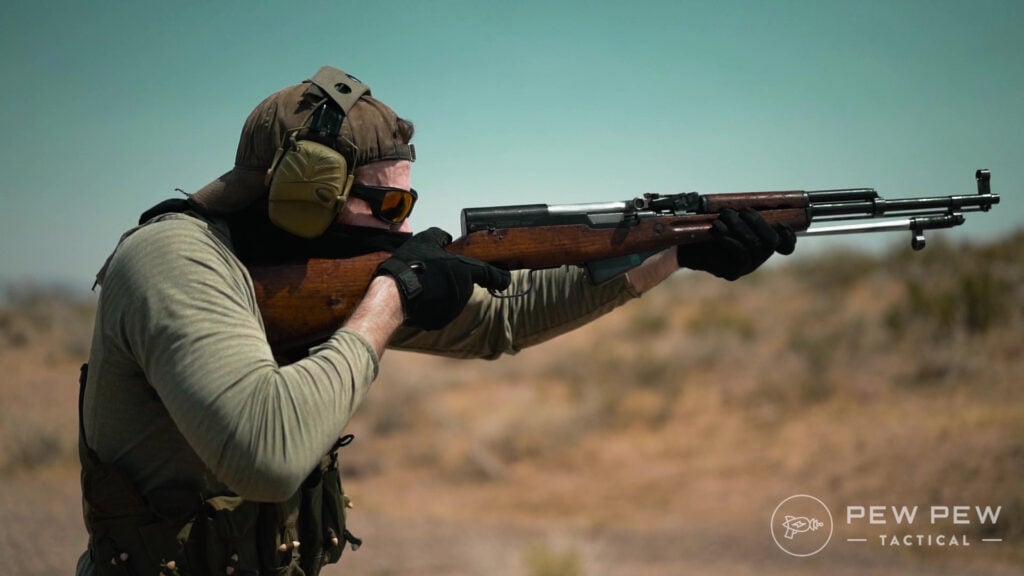
Finish off the rifle with an old-school Chinese chest rig and a pile of stripper clips to get the complete experience.
You can read more on the SKS in our SKS: Norinco & Yugoslavian Variants review or Chinese Type 56 SKS review.
2. M1 Garand – Best US Mil-Surp
Prices accurate at time of writing
Prices accurate at time of writing
-
25% off all OAKLEY products - OAKLEY25
Copied! Visit Merchant
Pros
- World War II champ
- Very accurate
- Iconic “ping!” on the last round
Cons
- Expensive
Specs
- Caliber: .30 Service (.30-06 Sprg)
- Action: Semi-automatic
- Loading: 8-round en-bloc clip
- Barrel Length: 24″
- Overall Length: 43.5″
- Origin: USA
The world’s finest battle implement, the M1 Garand, is also one of the best semi-auto rifles on the milsurp market.
It’s also one of the more expensive models and can be somewhat tough to find.
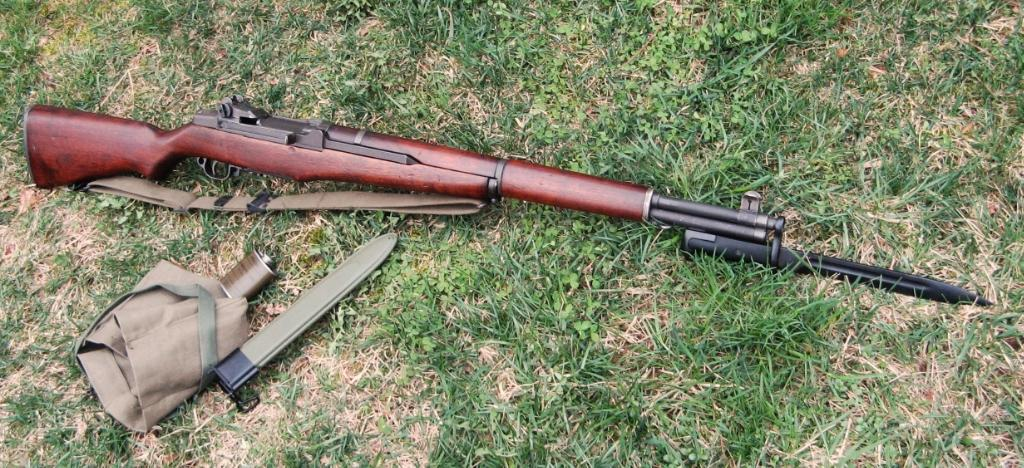
The Civilian Marksmanship Program sells U.S. surplus M1 Garand models, but that requires a membership.
Sadly, lots of folks are members who buy these M1s and resell them at astronomical prices. So, it’s worth the admission into the CMP and a better option than buying from a flipper.

The semi-auto action and rapidly reloading design made the American soldier a force to be reckoned with in a field of bolt-action rifles as we entered World War II.
It fires the .30 Service cartridge, aka the .30-06. This ammo is common and available but not exactly cheap.
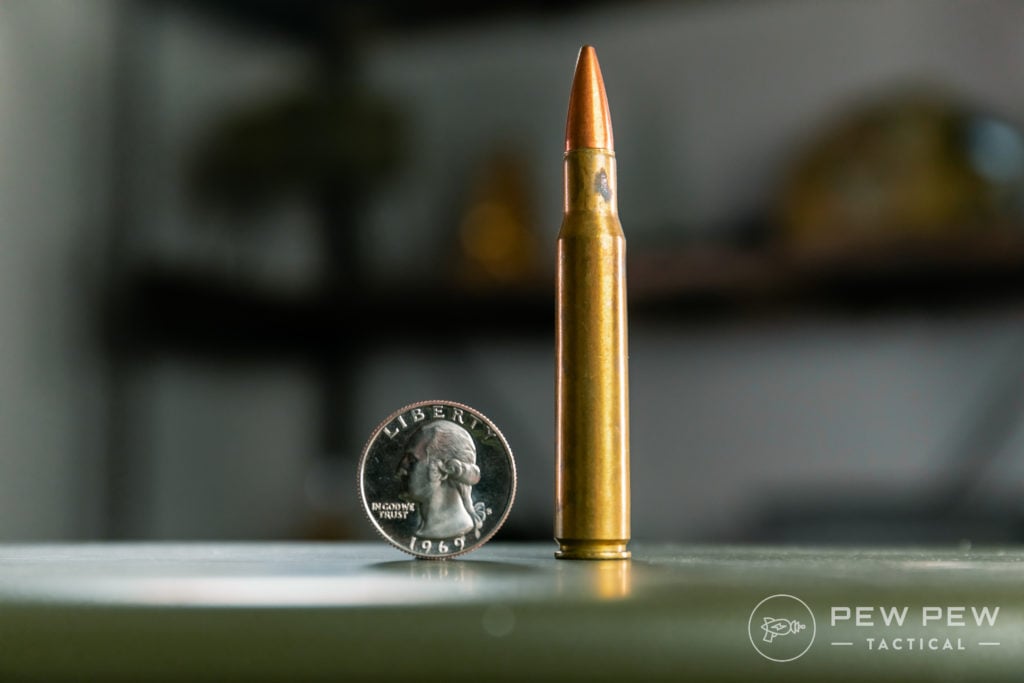
These gas-operated rifles are wonderful to shoot and truly a mechanical sight to behold. Not to mention, surprisingly accurate for the time. They would still make a very effective hunting rifle.
If you are a member of the CMP, then you owe it to yourself to take an M1 out to a high-power competition and have some fun.
The M1 uses an en-bloc clip and internal magazine. Those en-bloc clips are still widely available today and easy to find.
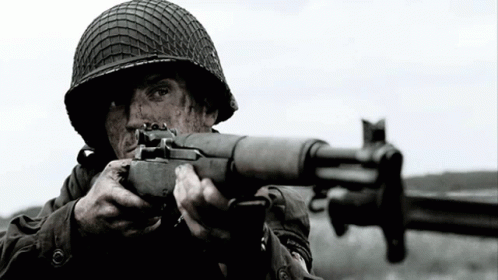
A cartridge belt replica and a belt full of clips will make you well-equipped to storm beaches and kill Nazis. Don’t forget the bayonet!
What do you think of the M1 Garand? Let us know by giving it a rating below.
3. Karabiner 31 – Best Straight-Pull
Prices accurate at time of writing
Prices accurate at time of writing
-
25% off all OAKLEY products - OAKLEY25
Copied! Visit Merchant
Pros
- Typical Swiss Precision
- Very accurate
- Unique
Cons
- Ammunition is expensive
Specs
- Caliber: 7.5×55
- Action: Straight-pull
- Loading: 6-round detachable magazine
- Barrel Length: 25.7″
- Overall Length: 43.5″
- Origin: Switzerland
Regardless of whether you’re really into milsurp or not, you’re going to dig this one.
Known for the straight-pull bolt, the beer keg charging handle, and a gorgeous Swiss shield, the Karabiner 31 is a sweet model for shooters and collectors.
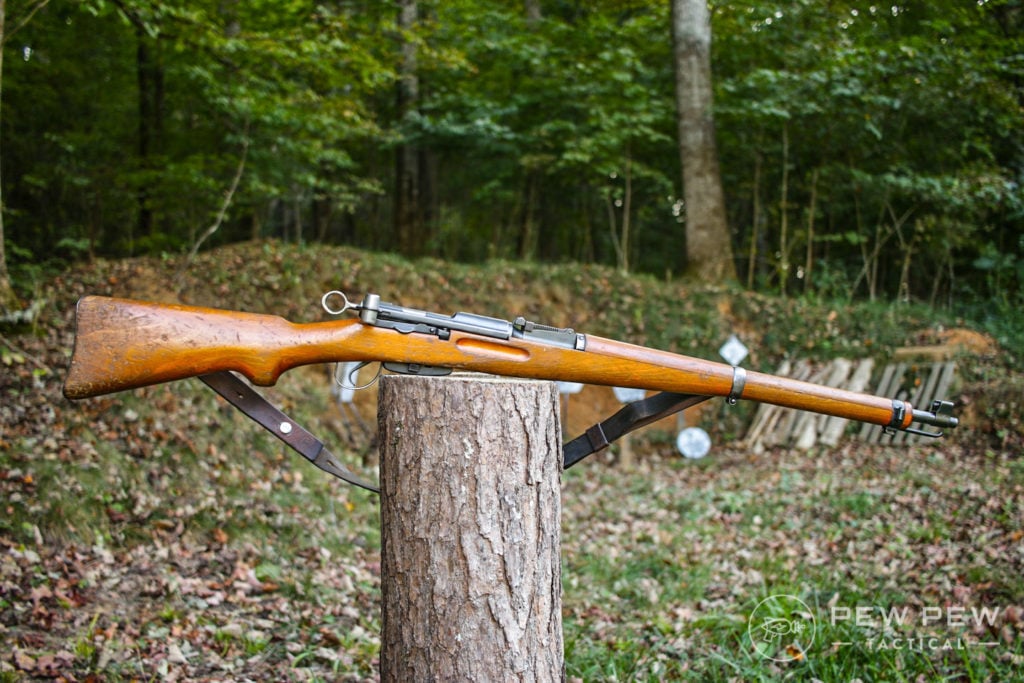
Built on a reputation for excellent machining and craftsmanship, the K31 doesn’t disappoint. It offers legendary accuracy firing the 7.5x55mm Swiss round.
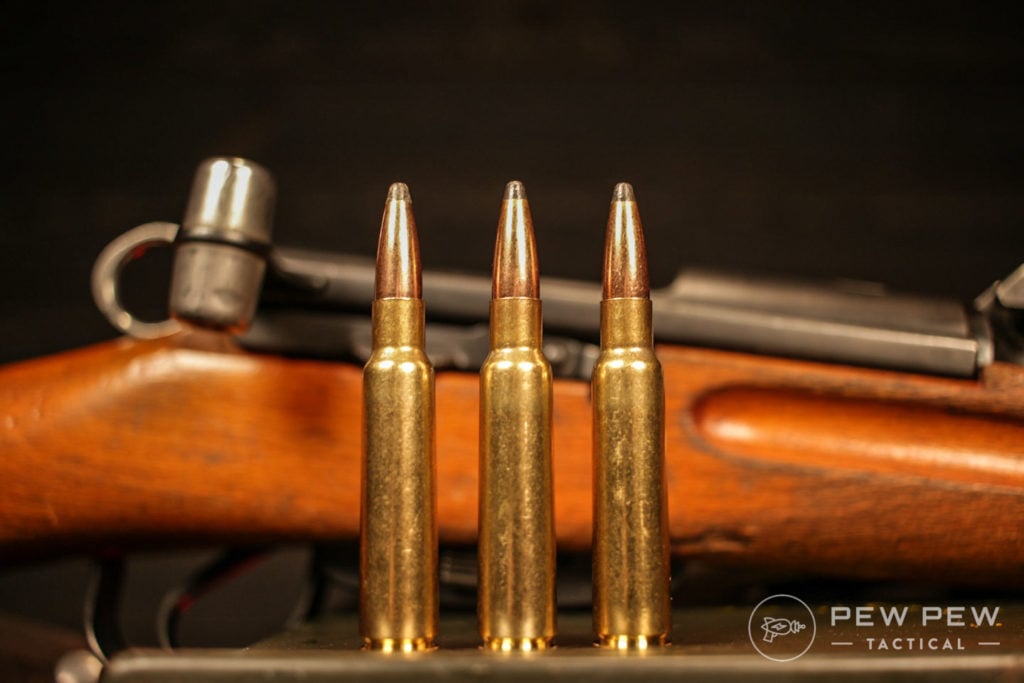
Many military rifles murder your shoulder, but the felt recoil on the K31 isn’t too bad. I’ll call it medium and certainly manageable.
Be wary that it feels a bit heavy, and ammo is expensive. But with a unique cartridge like that, it’s to be expected.
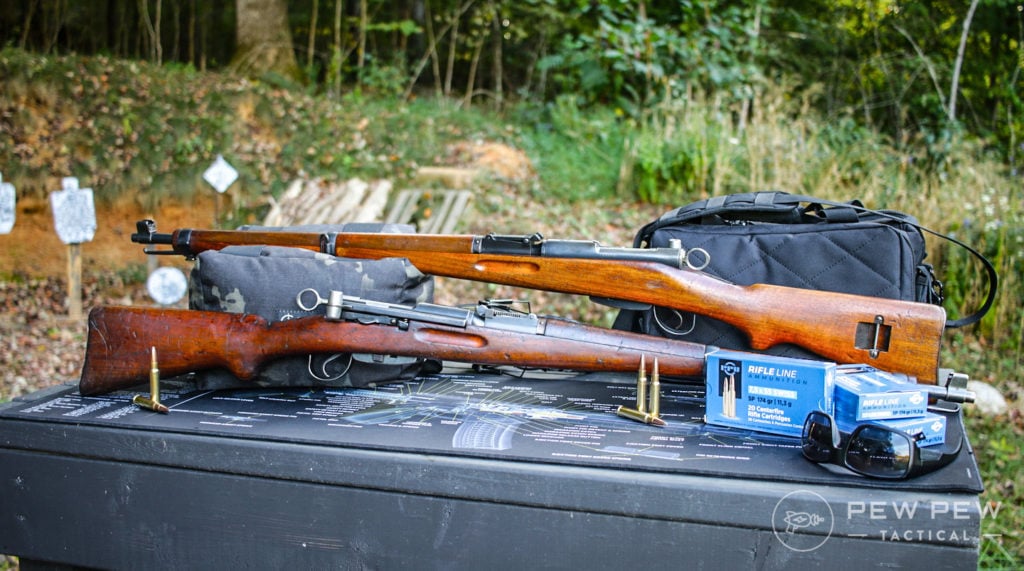
But aside from that, the K31 is a fun gun to shoot…and even better to show off.
Be sure to read up on our review of the K31 or watch the video below!
4. Lee-Enfield – Best Bolt-Action
Prices accurate at time of writing
Prices accurate at time of writing
-
25% off all OAKLEY products - OAKLEY25
Copied! Visit Merchant
Pros
- 10-round capacity
- Fast action
- Good accuracy potential
Cons
- Shorter length of pull
- Ammo isn't cheap
Specs
- Caliber: .303 British
- Action: Bolt-action
- Loading: 10-round box magazine loaded with 5-round stripper clips
- Barrel length: 25″
- Overall length: 44.5″
- Origin: United Kingdom
The Lee-Enfield has undergone many revisions since its original introduction in 1895.
But for this article we are specifically looking at the No.1 and No.4 variants, which are the most iconic and popular versions.
These rifles have a very robust, reliable action, and are noted for their smooth cock-on-close action and higher 10-round capacity. They are often associated with the “mad-minute drill” that required soldiers to put at least 12-15 rounds on a target at 300 yards within a minute.
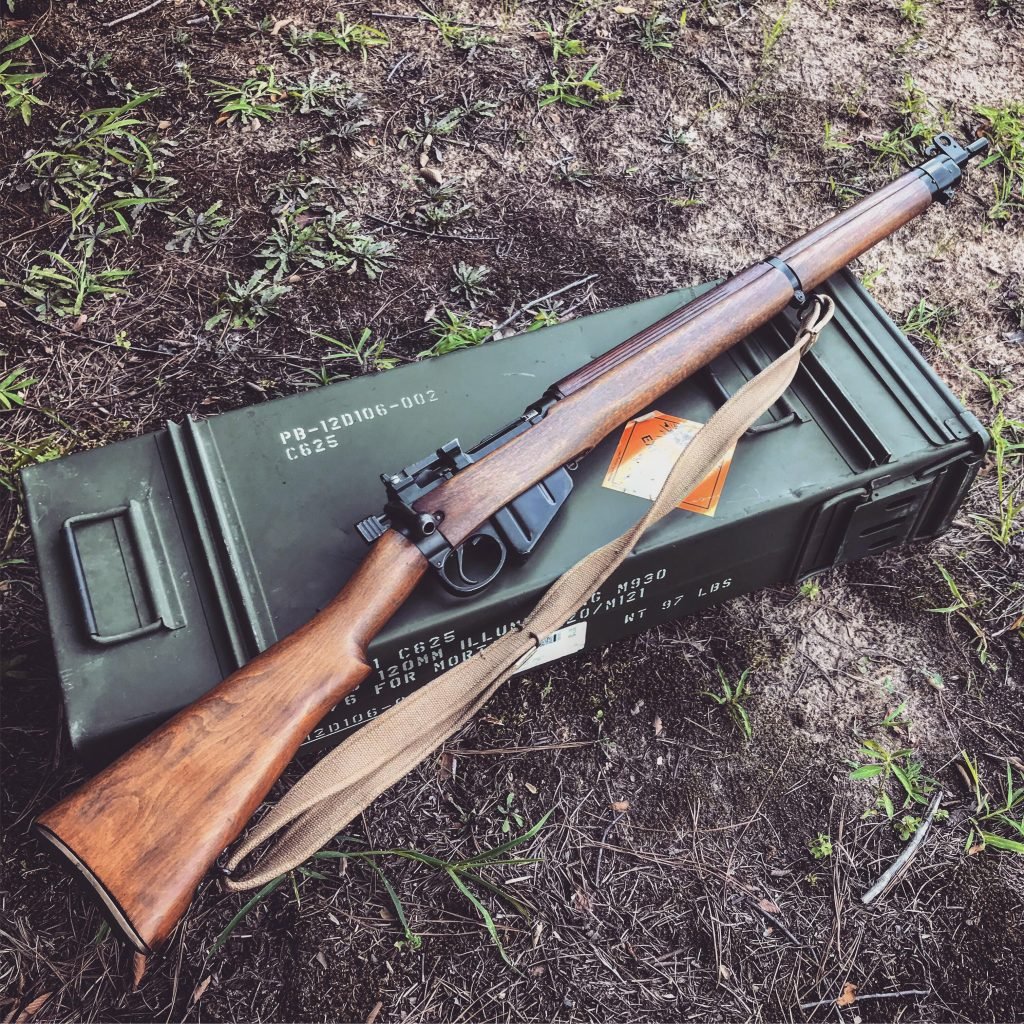
As mentioned, the Enfield boasts a 10-round capacity and can be loaded using two 5-round stripper clips. This is double the 5-rounds that most standard bolt-action rifles of the era held.
Recoil-wise, the .303 British round is about on par with .30-06 out of a bolt-action rifle of similar weight. While the short No.5 jungle carbines might look appealing, the recoil is pretty heinous, hence our recommendation of sticking to the classic No.1 and No.4 versions.
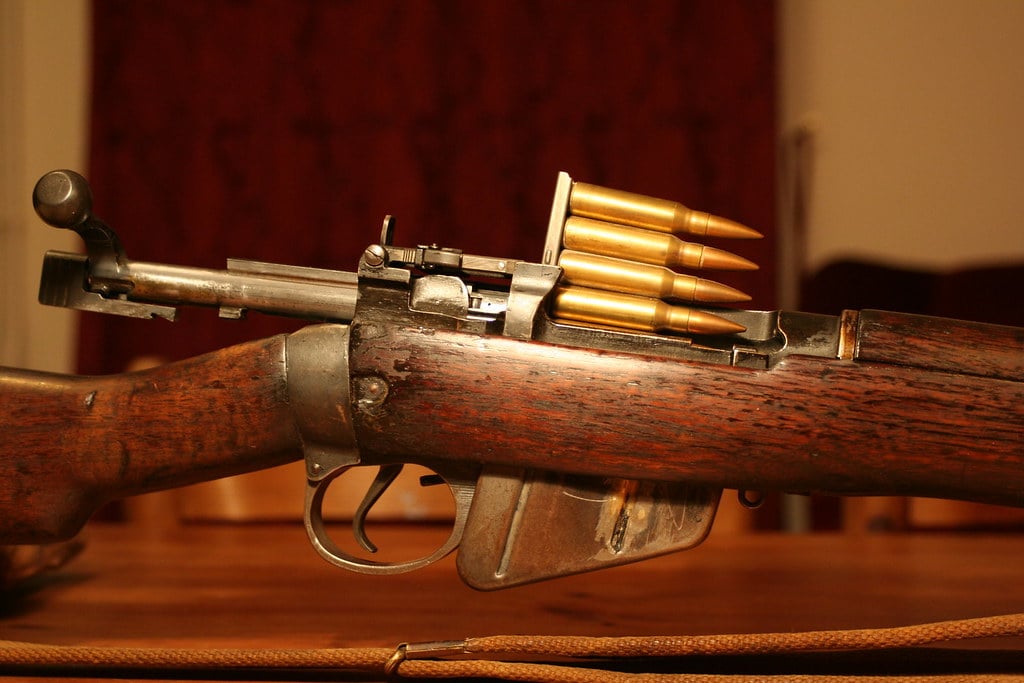
Enfields have managed to stay a bit more stabilized in price over some other guns like the Mauser K98 and are even cheaper than many of the Mauser clones like the Yugo M48s.
These are awesome shooters with a ton of history behind them and are a great addition to any mil-sure collection.
5. Mosin-Nagant – Best Budget Rifle
Prices accurate at time of writing
Prices accurate at time of writing
-
25% off all OAKLEY products - OAKLEY25
Copied! Visit Merchant
Pros
- Relatively affordable
- Ammo isn't as expensive as some other mil-surp
- Easy to find
Cons
- Stiff action
- Rougher fit and finish
Specs
- Caliber: 7.62x54mmR
- Action: Bolt-action
- Loading: 5-round integral box magazine
- Barrel length: 20.2″ – 29″
- Overall length: 39.9″ – 48.5″
- Origin: Russian Empire
Mosin Nagants have long been the go-to surplus rifle for those new to the world of milsurp. This was mainly because they were widely available, as was surplus 7.62x54mmR ammo.

The price of Mosin has risen drastically in the last few years, due largely in part to a new generation of shooters, dwindling supply, and video game popularity.
Although the days of $89 Mosins and cheap 54R spam cans are gone, the rifles are relatively affordable as far as mil-surp goes.
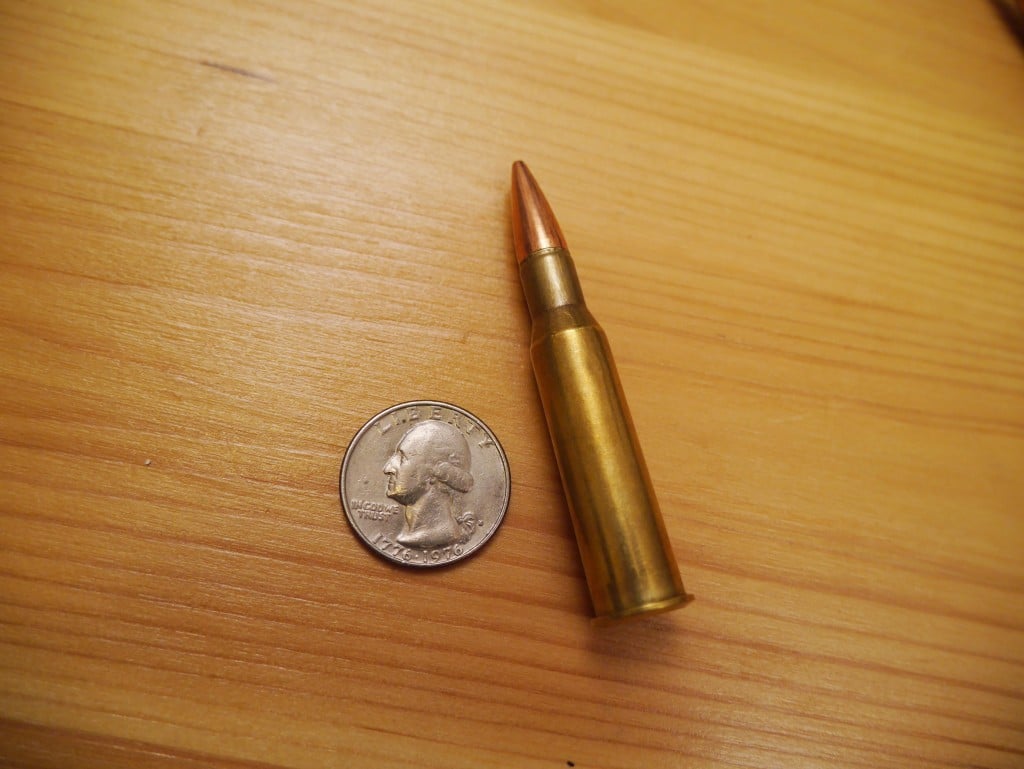
Like the Lee-Enfield, there have been a ton of variants of the Mosin-Nagant since its inception. The rifle has been around since 1891 and has been used in nearly 50 different major wars and conflicts.
While these are solid rifles, they do exhibit the typical Russian standard of manufacturing.
Lovingly referred to by many as the “garbage rod”, Mosin actions aren’t as smooth as the other rifles on this list, and they are definitely rougher around the edges (unless you spring for a Finnish Mosin).
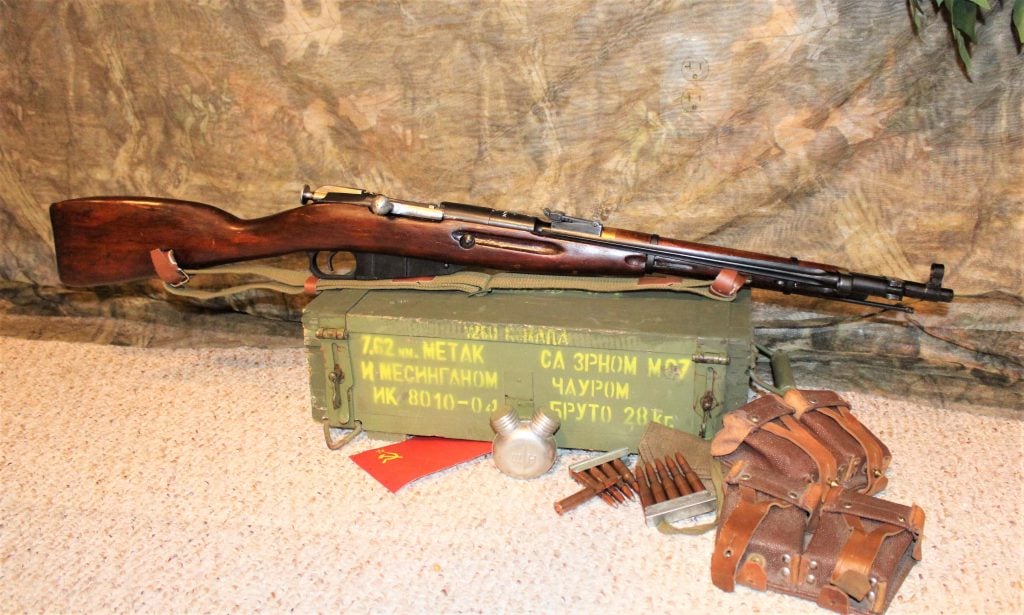
However, the rifles are rugged and have clearly withstood both the test of time and the test of new young shooters abusing 100-year-old guns.
Again, we typically like the longer variants, such as the 91/30. But if you like shooting fireballs and feeling some mighty recoil, the M38 and M44 carbine variants are pretty easy to find as well.
Why Shop Military Surplus?
For new and old gun owners alike, the world of military surplus firearms is sometimes overlooked — often considered to be for collectors only.
However, milsurp rifles and firearms tick a lot of boxes relevant to anyone looking for a new rifle.
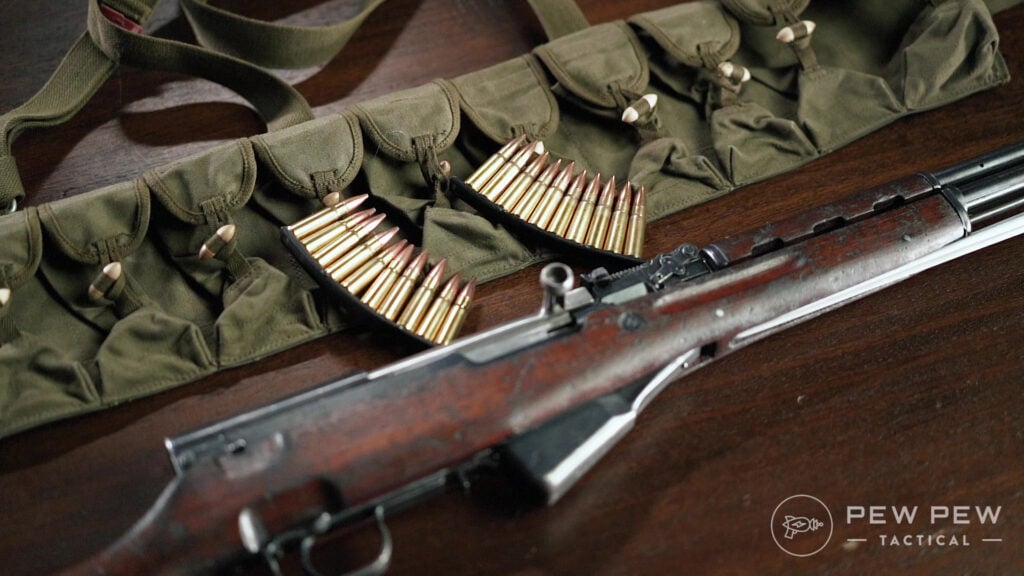
Fun to shoot? Check. Handsome to look at and display? Check. Budget-friendly? Check; well, sometimes.
The bottom line is that military surplus rifles are worth researching for aspiring or experienced gun collectors and make for excellent rifles for shooters of all levels of experience.
How Much Do Military Surplus Rifles Cost?
It isn’t unusual for an owner of a single gun to quickly find their collection growing as their budget allows.
Owning guns is sort of like saying that you are just going to take one bite of your favorite food and then winding up eating the entire thing. One taste is just not enough.

However, the prices of guns can make it a challenge for a budget-minded gun owner to grow their collection at a fast enough rate to satisfy the itchy trigger fingers that are hungry for new triggers to pull.
Sure, a brand-spanking new AR-15 with a full array of rails, accessories, grips, and optics is a sight to behold and a joy to take to the range.
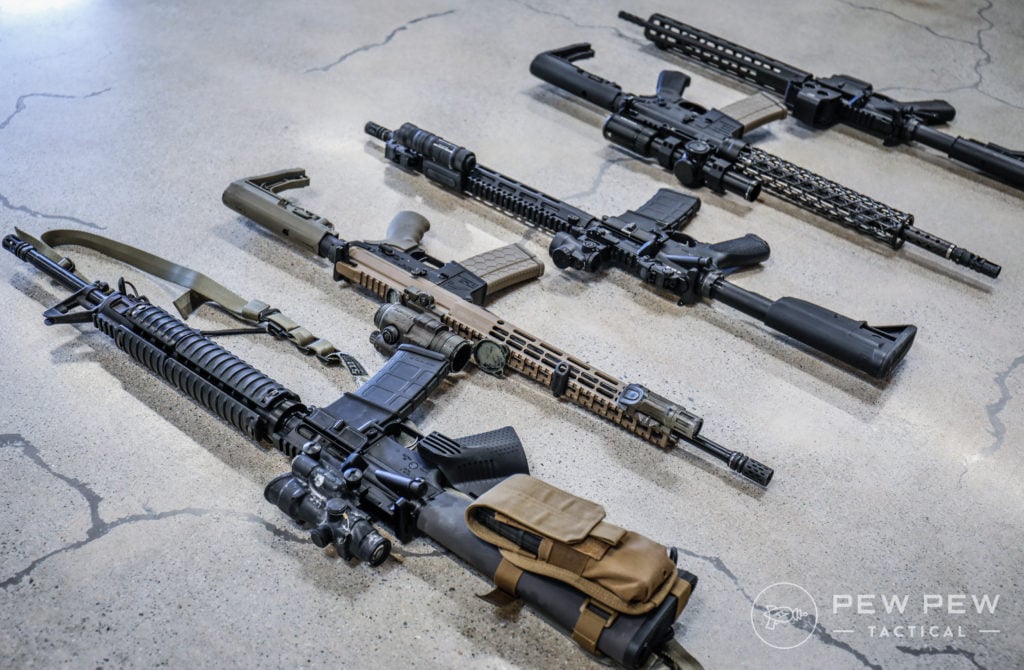
However, that same AR-15 can quickly soak up even an ample gun budget.
Milsurp rifles offer a slightly more budget-minded approach.

Where to Find Military Surplus Guns
Searching for military surplus rifles and accessories can turn into a sort of treasure hunt.
That’s part of the fun!
I enjoy finding out of the way gun stores and military surplus stores and stopping by to check out what they have. I have come across some great deals using this method.
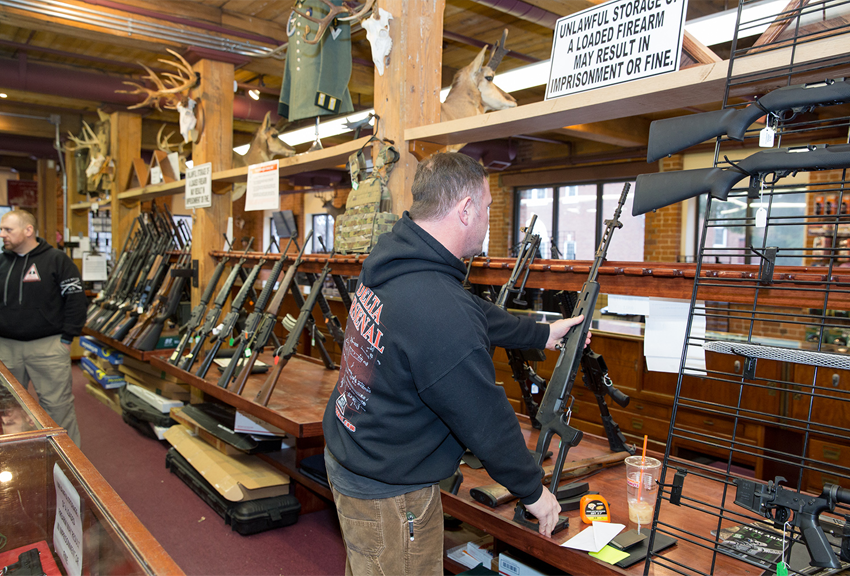
Gun shows are pretty much a one-stop shop for most common military rifles as well. And some online dealers also offer milsurp too.
In short, shop around and keep your eyes peeled.
Why Trust Us
The Pew Pew Tactical writing crew is full of dedicated shooters and more than a few collectors. Collectively, we’ve got experience with everything from World War II to the Global War on Terror covered.
We love the latest bougie rifles from today’s manufacturers, but a little nostalgia never hurts – especially when it’s cheap!
FAQs
Does the Military sell surplus guns?
The U.S. military does sell off unwanted rifles, but not to us. We can buy lots of great historic military rifles through gun stores and auctions, though.
Can civilians own military surplus rifles?
We sure can! The usual laws still apply, but there's nothing saying we can't own a certain rifle just because it was used in a military capacity at one point.
What's the best military rifle ever made?
That's a tough one! Got a favorite? Drop it in the comments section and brace yourself for a heated debate!
Final Thoughts
This article doesn’t even begin to cover the huge variety of surplus firearms available to collectors and firearm enthusiasts.
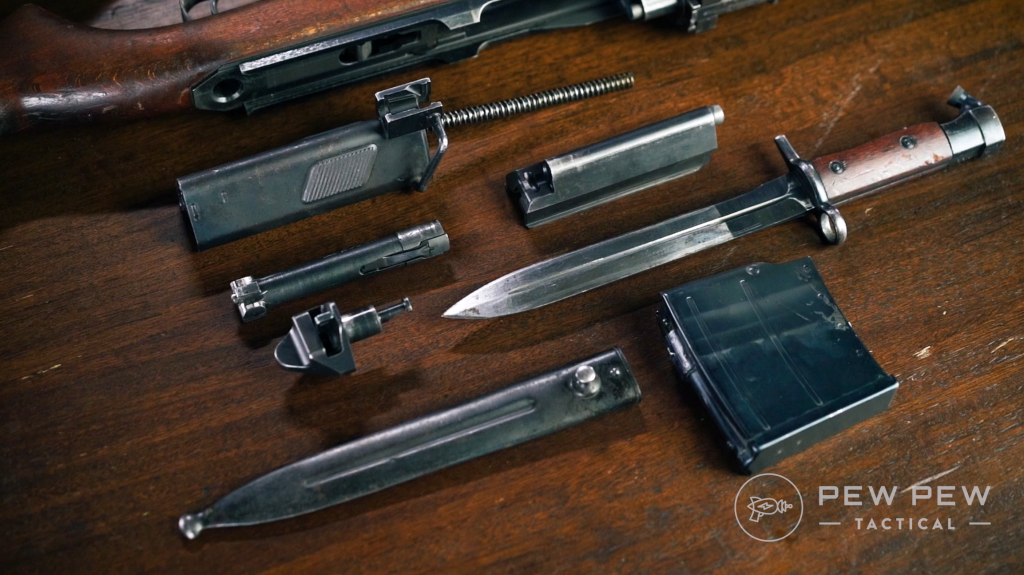
Bottom line: military surplus rifles are a great way to enhance the hobbies of shooting, gun collecting, military history, hobby-level gunsmithing, and hunting.
Just don’t be surprised if you set out to add one rifle to your collection and wind up with a new interest that quickly has you stalking gun show floors for more pieces to add to your collection.
What models do you own? Let us know in the comment below. Also, be sure to check out our round-up of the Best Military Surplus Handguns.
Latest Updates
July 6, 2024: Removed Yugo M48 and Chinese Type 53 rifles. Added Lee Enfield and Mosin-Nagant rifles. Updated supplemental media.
June 10, 2024: Added more detailed product information and sections on how we tested and selected the rifles on this list. Removed the M91 Carcano, Hakim and Rasheed rifles, and Remington 870 Wingmaster. Updated supplemental media.

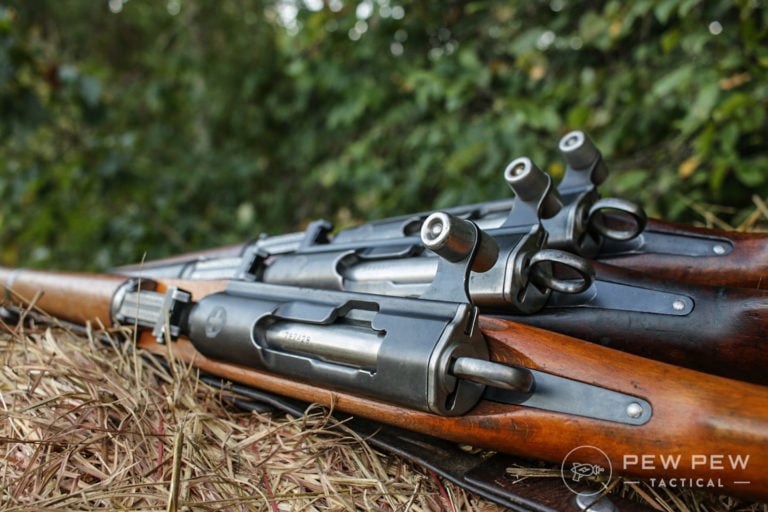












99 Leave a Reply
Great article! I'm curious as to why the T53 Nagant was removed from this list (in July of 2024 according to the updates section)? Is it an availability thing?
I have one, my first and only firearm in fact. It's a bit beat-up, but a buddy and I put 20 rounds through it at the range recently and it functioned flawlessly.
See the editor and proof-readers took the day off. Again.
I have no doubt that there are inexpensive rifles that can be found for purchase, and I own a Garand that’s in beautiful shape — even had my gunsmith do a few mods that actually improved its accuracy. In a pinch, it will serve as a decent hunting rifle. But the rifle was a gift — and as much as I wanted to own one, never purchased it.
While Pewpew occasionally publishes an interesting article, perhaps the reader should consider their purchase: are they building a collection, or putting together a number of firearms that will serve a distinct purpose? A collection of rifles isn’t very cost effective, and spare parts for military surplus weaponry can be problematic. Surplus rifles hold value primarily to those who build collections — and if our economy gets much worse, owning a used military rifle with limited capabilities may actually result in the rifle being indefinitely relegated to the corner of a safe somewhere. What then of the money spent? Could it have purchased something far more useful?
My late wife would come home and exclaim that she saved a lot of money. How? She didn’t buy anything? No… she had a car full of her purchases. My point? Are you saving money buying a surplus rifle? Is the one that will be selected by some faceless, nameless clerk an unused rifle in mint condition, or has it been beaten to death in some hellhole somewhere: remember, you can be promised anything.
A shyster in Los Angeles, Ralph Williams, sold used cars on TV for years, buying bulk ad time on late night television. He had some older cars that appeared to be in good condition at extremely low prices — but buyers usually found there was a bait-and-switch done; some buyers were sold vehicles that had no engine and didn’t understand what “as is” meant. Others found that their vehicles were totaled-out wrecks rebuilt that had twisted frames.
There are significantly better rifles to own if you want one firearm to adequately serve many needs, I recently found a rifle made of composite materials, has a carbon-fiber wrapped barrel, that is sub-MOA and borders on hyper accurate, and weighs less than 9 pounds equipped with an excellent scope, full magazine, and sling. From the first round fired to the last with a hot barrel, the impact point doesn’t shift. Which rifle would you rather have? The worn-out military surplus rifle with iron sights, whose construction doesn’t lend itself to adding a Picatinny rail for a scope, that shoots expensive ammunition, or a modern rifle that weighs less, is far more accurate, takes large detachable magazines, and has the capability to be upgraded?
Whatever your purpose — and there’s nothing bad about having a collection — use common sense. Is the purchase of a rifle you make as an investment for selling later going to keep up with inflation? Are the assumptions made about ammunition and spare parts availability and cost always going to be valid?
There are many companies that earn profit by persuading you to make purchases, to build collections, to buy buy buy. Convenience has a price, and how much are you paying for it? Ask yourself if you want to pay for this, or can you do better on your own? That link you click on has a price.
Well quite a few years ago now I was out with my cousin and doing some shooting with an M-1 carbine. Just some general shooting cans and gongs. He liked it a lot and thought about getting one till he saw the price. I spotted a crate of surplus SKS selling for $99 dollars each, like I said it was a while ago. For what we were doing it was fit the bill perfectly and back then surplus ammo for it was CHEAP by the case. Better yet sold it to buy his first AR eventually. Got 3X what he paid for it. Today quick look on Gun Broker shows $600 to be around the price for one in average condition.
You can buy a lightweight Choate composite stock on it for what like $75. They have AK mag adapter on them but why. A picatinny rail adapter isn't to hard a job to put on it. Find a relatively inexpensive scope or say a Sig romeo5. I'm sure it isn't anywhere near sub MOA. But for a handy little rifle that is fun to shoot, with still relatively inexpensive ammo compared to others. That equals an afternoon of fun. At nowhere near the cost of the rifle you described
I own two of them: a Garand I bought in 1995 for $367 and a Mosin I got when you could still get one for about $100. I enjoy shooting both. I made a pistol grip stock for the Garand that makes it more fun to shoot and recently sent the Mosin bolt for the bent conversion. If you wonder about a thin wrist on the Garand, I drilled from the inlet into the stock and inserted a 6-inch rod into the epoxy-filled hole.
Great article but I think you missed the boat not including the Japanese Type 99 Arisaka. True the 7.7x58mm Japanese cartridge is getting arder to find, but certainly no harder than the Swiss 7.5x55mm. And a good non-Bubba-ed Type 99 can be had any day for under $500, a good entry level price for a very solid, and in the case of my Dad's WWII bring back, a very accurate rifle. I think the Type 99 is a great gun with which to start any milsurp collection, hope you guys give it a review some day, if you haven't done so already.
If you are looking for Enfields, consider the Ishapore 2A or 2A1. The Ishys shoot 7.62 NATO.
Not sure if CMP still has in their inventory the M1 Garand that were chambered for .308 Remington (they might offer a service/parts to switch. Caution on the .30-06 chambered Garand; never use modern pressure cartridges that could bend the action rod. Note: there are gas chamber plugs with bleed valves to adjust for over pressure that can be purchased to replace the mil-spec plug.
Excellent point, which is rarely emphasized.
When I received my Garand as a gift, I foolishly went out a purchased a case of modern .30-06 ammunition. Before firing the first round, my gunsmith, who went with me to the range to help me learn how to avoid Garand-thumb, stopped me and provided the proper ammunition for my use.
We purchased 5,000 rounds of surplus ammunition, took the rounds apart for the cases and projectiles, then remanufactured the rounds with better primers and propellants, custom-seated for my rifle. Why do this? He had several clients who were never warned about case pressures of modern ammunition and damaged their rifles with its use.
I turned my yugo mauser into a sporterized 22-250 AI; it puts all the bullets into the same hole at 100 yds. So, i guess, in summary: "good".
I inherited an Arisaka type 99 in 7.7 jap along with the sporterized 1903 Springfield Remington with the flaming bomb stamp. Family member capped a sniper WW2. Not on the list but that's the start of my collection. Going to buy an SKS - helpful writeups thank you. Got the original Leopold scope seems decent for 1943...
Great...now I have to try to find the Egyptian ones. I have all the rest...
I have two sks’s one is a Chinese and the other is Russian and also a mosie nagant
Unless you can get three rounds off in only six seconds and score two hits on a moving target 250 feet away, don't bother with the Carcano.
Hehe, I see shat you did there…
I’m amazed that Pewpew didn’t upsell the Mannlicher Carcano: there’s over a hundred thousand sitting in an Italian warehouse somewhere, certain to make the Pewpew mob enough beer money from the graft.
The K31 is definitely a favorite. If I'm not mistakes it also holds the world record for unaltered, iron sight, long distance hits (partially also due to the ammo).
I have no problem hitting small watermelons at 600m with Open sights.
Although heavy, it's a great quality firearm few can match.
Swedish Mausers M96 and M38
Springfield 1903A? Best deer rifle I ever had. Bought it in a KMart for $19.95 in 1970. Wish I still had it. Traded it for a 1953 Pontiac with a straight eight.
I purchased a Pontiac Firebird for my girlfriend. Best trade I ever made.
I have a Mosin nagant I picked up around 2013 for $115 in NC. Manufactured in 1933, hexagonal receiver. Came with cleaning kit and rod, tool kit, oil tin, shoulder strap, and a few mag pouches. Looked like it hadn't been fired. It shoots fantastic.
How about Chilean Mausers? hello?
Pew Pew I enjoy many of your articles and I really appreciate your work I do have a suggestion.
You give honest reviews and post prices but more often then not the prices you post are not accurate...even on the links literally just posted like the SKS.
For example on the SKS in this article you said they can be had for 499 and provided a GunBroker link. I clicked on the link and it's 699.
Old articles old links I get it. Prices change. No harm no foul.
However if you're posting a new or updated article please do the research and update the price.
I didn't look beyond the SKS but you listed the price as 499. I clicked on the link it's 699.
Please update the price when you are posting a new or updated article. This is not the first time actually it's just about every time I read a PP article.
I know it's a lot of work and you already have a lot on your plate. But please update your prices when you update your articles.
Anyone else with me or am I alone on this?
This could be an example of what might be called bait and switch lite. The dealer quotes a price to PP and then lists a higher price on his sight. You don't have to pay it, but the hype is planted in the article and if you want the goody, then you pay the higher price.
David maybe it wasn't intentional, but I can't believe you left out the M-1 carbine. That is a great shooting little military weapon.
SKS @ $645. Wow. I wish I'd have bought a couple of crates worth when they were $75 pick o the barrel in the 80's
Looking for 7.65 Argentina carbine, price rifle and ammo
Looking for a Swiss K31 to add to collection.
Have a K31 for sale. Owned by a good friend who lived in Switzerland, and whose father was part of militia, where he acquired the gun as part of that duty. Serious offers only please.
I’ve got a 30-40 krag made in 94 and still haven’t seen another one like it yet I’ve had it since I was 14 I’d smoke everyone at the range but now I can’t find much ammo sadly I don’t shoot much anymore, awesome article btw thank you!.
I collect Arisaka rifles both calibers and also Carcano 6.5 x52 rifles. And like you said it’s very hard to stop once you get your first one. By the way I also have a few Steyr m-95 carbines.
hey david im a david too ive been looking for an arisaka type 99 safety knob for the early models do you have one you might sell
Bro I’m having the most problems getting ammunition for my 7.7 Arisaka any suggestions & trusted suppliers.so expensive.Help
Ammoseek.
I am more than a little interested in a few of these rifles, but I couldn't find a price and I was wondering how I could.
there are still Gun auction sites, such as gunbroker, and gun auction. Some milsurps are getting harder to find in decent shape, and the prices are always on the rise. Also Classic Firearms offers milsurp rifles. Good to do your own research to decide what is a fair price, for the firearm you choose.
word in here, if you think you would like to get into collecting, get a Curio and relic license. It will save yo $25-$35 on every purchase
One I didn't see mentioned is the arisaka type 99, great and accurate military surplus rifles I owned one. The barrel had been reamed out for .30-06 by the Americans in WWII. Pretty neat, had to quit firing it though because the barrel's structural integrity had been weakened from age and the reaming. Probably the most accurate rifle I have ever shot.
Had I known that the SVT-40 Tokarev was such a great rifle with the correct (steel cased) ammo, I never would have sold it. Unfortunately, it destroys the brass ammo which works so well in the Mosin. Live and learn.
My brother and I began collecting milsurps about 20 years ago; mostly due to our childhood being spent shooting military bring backs that both grandfathers owned. We have an armory but here are a few of my favorites.
1. M1 Carbine: Lightweight, no recoil, deadly accurate, must have in the bug-out bag
2. Vzor52 or CZ52 pistol: arguably one of the greatest pistols ever made. Power+accuracy+durability+cool factor. The Czech 7.62 round is designed 25% “hotter” than the standard 7.62 round. This pistol can put a round through some level 2 body armor (I’m not allowed to specify) and into the wall behind the target with minimal deformation to the bullet.
3. Swiss 96/11: the most accurate rifle of WWII, the Schmidt-Rubin Model 1896/11. Being over 4ft long and firing the Swiss 7.5x55mm round; the 96/11 is not really a rifle but miniature artillery for your shoulder. If the guys at your range are not rubbernecking yet then the straight pull bolt action will get their attention. Especially when you rechamber a round and the casing shoots up vertically and busts the light above your booth.
My favorite is the M1 Carbine. Easy to shoot, 15 round mag. I don't know where my dad got it but he had me shoot it as a kid. When he passed, it was the one weapon that I made sure to keep from his collection.
I have several military surplus rifles. My prized possessions are a Garand, post World War II production by International Harvester and a 1903 A 3 by Smith Corona in 1943. My second tier is a Yugo Mauser, a 24/47 and what appears to be a very late production K 98.
Boy! my wife got me hooked on Mauser when she bought me a surplus 24/38 Czech for about $90 in 1997. This gun was in rough shape with missing and damaged parts.(Nothing serious!) But you knew that it had been abused a bit!
Back then I was too busy making a living to really go out ad shop for parts. But now that the kids are gone,(And the wife) I have been finally able to start in on it after doing a lot of homework on this arm, and it's brothers. It has been an enjoyable experience! My boys an I have taken it out on many occasions into the woods and hunted with it, or done target shooting.
My boys still recall those days!
when Pass on, this rifle, and my others, will be passed down along the memories that my boys have now, and will create with their kids!
I found an awesome website that had all of the old Russian military weapons around 6-7 years back. I bought my Mosin Nagant from them but they had them by the crate for cheap and lots of other pistols, rifles etc. I cannot for the life of me remember the site or find them. Does anyone have any ideas? I purchased my Mosin for around $150-200 if u remember correctly. Any info of a site similar would be appreciated. Thanks.
I found that militarysurplususa.com has good overall prices for Mosin Nagant parts as well as the rifle itself.
Try Empire Arms in Florida
Another is Royal Tiger Imports.
Does anyone know where I could purchase an old Turkish Mauser? I’m trying to buy my first old rifle so I don’t really know how to search for one.
I highly recommend Guns.com. I've used them a few times now and it's great, very good prices too on older rifles.
Thank ya sir, I assume I’ll have to check in regularly with the store for one in stock?
Probably, things like that are hit and miss.
Oh ok thank you! Have a good one
You might check newspapers for estate sales. I’ve found a few gems at these such as shotguns, pistols and one old British rifle, a Mk 2 Martini-Henry 450 Boxer-Henry .577 rifle from the 1870s that was in fair condition, handed down several generations until I found it.
You only have to be persistent, diligent, and use common sense.
I bought my Mauser 96 around 20 years ago for $100. it's dated 1904 and has a bright bore. I sporterized it with new sights, turned down bolt. completely dismantled polished and hot tank blued the entire gun. It is very accurate and a lot of fun to shoot, one I will never sell.
North of the border collection
SVT-42($225 US)
long branch Lee Enfield 1942 ($55 US)
Russian sks ($230 US)
I got the milsurp sickness in 2016. My first rifle was a Mosin 91/30, that looked like new, with bayo, oiler, ammo pouch and tools for $180. After that, I bought a Lee Enfield No1 MKIII. Three years later, my collection includes:
1. Mosin 91/30
2. Enfield No1 MKIII
3. Arisaka Type 38 carbine with MUM cover
4. Arisaka Type 99
5. K98 BYF43
6. Gewehr 98 Waffenfabrik Oberndorf
7. Springfield M1 Garand
8. Inland M1 carbine
9. Smith Corona 1903A3
10. Winchester M1917
11. SKS
And, the bayos of all the previous rifles. WWI bayos are closer to swords than to a knife! I just love to see my 1917 with the bayo. Scary!
Although the following shotguns aren't milsurp, the models were used in WWI/WW2 and later. Mine are commercial models, but I bought them because they were used by the military:
1. Winchester 1897
2. Winchester Model 12
3. Ithaca 37
4. Savage 775A (Browning Auto 5 clone)
Someday, I would like to have:
1. Gewehr 43
2. SVT 40
3. 1903
4. Enfield No4 MKI
5. Enfield P14
6. Henry Martini in .303
7. K31
8. Carcano
9. Johnson rifle
10. Ross .303 rifle
11. MAS bolt and semi rifles
There are many guns that Id like to have, but I'll never have the $ to own one. Like:
1. STG44
2. MP40
3. Thompson SMG
4. Grease gun
5. Sten gun
6. FG42
7. PPSH 43
8. M14 full auto
9. M2 carbine
10. MP18
11. BAR
And of course, ammo to fire all those guns!
How about a Mk 2 Martini-Henry 450 Boxer-Henry .577 rifle, built 1873? Sorry, no ammo.
What rifle is in the second picture under the "Why Buy Military Surplus?" category?
Soviet SKS
That is not an sks but a Svt-40 I'm afraid, although both are quite similar.
Yep, you're right. Thanks for correcting me!
Also, the photo of the Mosin Nagant 91/30 is not a 91/30. I believe it’s an M38. The M44, although similar to the 38, has a side folding bayonet.
I have a 1917 Eddystone 30/06 (based on the Springfield Armory model), it was part of a crate load my local dealer lucked into and it was still packed in grease! Once cleaned and given a once-over by their smith it was all mine and I LOVE shooting this rifle. It still has a smooth bolt action, competent iron sights and easy top loading internal magazine which has all taught me to be a better shooter. And the ammunition cost can be so low that I can EASILY go from one bulk sale buy to the next without dropping more than $250 (at the most) and I can multi-task the ammo between the range and hunting; and I don't lose any integrity hunting with this ammo so don't judge because it's low-cost.
I've recently become partially disabled and NEED to get out of the house, so I'm looking into Competitive Rifle Shooting for a new hobby and plan on using my trusty Army Surplus rifle. It's just so fun and easy to fire, it's become a passion. Good luck finding YOUR new/old passion ! ! !
Wow! If you don’t mind how much did that set you back and where is this dealer? Would love it get a surplus rifle, especially a US rifle!
The picture of the mosin is a 91/44 not 91/30
JUST A FEW=Mosin; Enfield(1mk3and 4mk1);spring03;spring 1898 Krag;M1;swiss1911;k98 last my favorite .52 Sharps rifle
I can't find anywhere where you can get a rifle for these prices. Can someone help?
They are getting to be higher than a cat's ass.
Canada ;)
I've got a 1943 Mosin Nagant with all matching numbers from the Izhevsk factory. Love the thing..though I do question why they decided to put metal on the buttstock..hurts the shoulder a bit.
The metal plate and, if you've noticed, short length of pull is due to the very thick coats worn by the soldiers who carried those rifles. Replace (keep) the metal plate with a rubber one and you'll notice a big difference.
Its for beating the pulp out of people
I don’t know which gun shows and shops he’s going to, but a $250 Mosin is about as rare as hen’s teeth. This seems a bit out of touch with reality.
Believe it or not, I recently purchased my first one (all matching numbers, with all the accessories except for the sling) for just around 200 bucks! Only been able to fire it a few times, and seems to be in great firing shape. I recently finished refinishing the stock and came out great.
That's pretty common, actually. I'm finding them all over for $150 to $250
I got one last weekend at the Dallas Gun & Knife show. Pristine barrel & action. $200. Shoots Great!
Have to say around 10 years ago picked up an excellent. mosin for the unbelievable price of 80 dollars still covered in cosmolean an excellent shooter when taken to range. Wish I had picked up an additional. 1 or 2 others .
I am a mil surplus enthusiast. I have about every rifle, swedisht mauser, Italian Carcono.. grerman k98,enfield and (Ishapore), arisaka (and last ditch with full "Mum"), 1873 mauser (deauteau) 1882 trapdoor mosin nagan t,91/30 (Tula star hex) and mosin M44 K31 and and 1911. Turkish Brazilian GEW, chilian ,columbian,And spanish. SKS. ,30cal Carbine. M-1 Garand, WW1 30-06 M1917 (Eddystone), 1908 manlicker P38 Byf 43 w/swastika P01 (manhurin) spanish ruby, , one I am missing is the French Mas, I'm sure I am missing a few with this post., and I am sorry if my spelling is bad It has taken many years of searching to find what I have.. oh and I am not a collector, I'm a shooter they are are in 100% working order w/ about a 2 to 3 inch at a 100 yards
I personally have stopped buying modern firearms, as they will be around for plenty long enough to amass a larger collection.However, I was able tot get my hands on 3 of the finest rifles I have ever shot. First being my Mosin Nagant 91/30 with matching numbers, made in 1943 in the Tula Factory. Second, My Fathers M14 service rifle from his time in Vietnam, also in pristine condition. Lastly is my Spanish Model 1893 Mauser, Unblemished, with matching numbers and no import markings.
Nice, Patrick!
Can you send me the website where I can buy all rifles
what I have seen I realy like .what do i have to do to buy your guns?
Hi Warren, we do not sell firearms.
I own a Lee Enfield .303, and a SKS, which I modded beautifully with after market pieces, and the FAL, plus a bolt-action .22 by Savage.
The LE is an awesome piece of history but my ammo was so bad that I didn't hit anything, and I had a hard time finding ammo. I have to try again this Summer. My SKS is awesome; it is a all black gun now and works great and looks modern. The FAL, although not surplus, is a fantastic rifle, not a small thing for sure, but it is credible and powerful.
I really want to add a K31 and a Mauser to my collection.
Thanks for the article
Great article and very timely in my case. I learned to shoot with a Mossberg .22 rifle given to me by an uncle almost 50 years ago. After a 25+ year absence I'm looking to get back into shooting rifles but wasn't sure where to start. I'm going to start looking into the ones you mentioned. Thanks!
Glad we could help you out, Alan!
You forgot the Carcano.
It was the Italy rifle that was made or design around same time as others you mention.
I'm a new shooter. And the information you guys provide really hit the mark. I love reading and learning and shooting. Thanks keep up the great work. TC NJ
Awesome, glad we could help! Be sure to let us know if there's something you'd like to see us write about.
This guy said it for me. Totally on the same track man.
Great... now I want a Swiss K31... and a Mosin... and a... damnit...
At least these are all relatively cheap!
There are many others that can be mentioned and probably should be such as the SKS, BM-59, and the Swedish Carl Gustav Mauser. SKS's, in excellent condition, can be found from the former Yugoslavian countries for $350, through good condition Russian or very rare Albanian manufactured rifles can run to $650 or more.
The SKS only barely got cut because we wanted to keep these on a pretty strict budget.
We'll be going into depth on more milsurp rifles soon and we'll definitely be including the SKS, Arisaka, and the Garand. The Carl Gustav Mauser and the BM-59 are excellent choices too for anyone interested in this kind of thing.
I got hooked on milsurp rifles after inheriting my father's German K98 Mauser. The most accurate gun I own and beautiful to boot! When it comes to reliability and ease of maintenance the old milsurp rifles can't be beat.
what kind of " local sporting goods store in 2017, carries a rifle manufactured in the 1800s? we have a specialty gun shop and big guns-how's as our ONLY means t to find these great tools !
I got hooked on Milsurp rifles after buying my first Mosin at a local sporting goods store. Now it seems everyone is on this bandwagon. I cannot find a Mosin for under $270. That's only $150 less than a brand new starter AR.
Dave, I was thinking the same. Eric, you and your team have a great thing going here! Best wishes. Look forward to the next post!
Great article. The main problem with surplus rifles is that you can't have just one, trust me! It's easy to get hooked and you'll be surprised with the accuracy you can attain if you practice. On another note I wanted to compliment you guys on a great site. I've instructed weapons and tactics for 35+ years, retired but still contract training. I recommend this site to many shooters. Thanks for leaving egos out and sticking to the enjoyment of shooting. Best of luck!
Thanks so much for the kind words Dave, we really appreciate it!